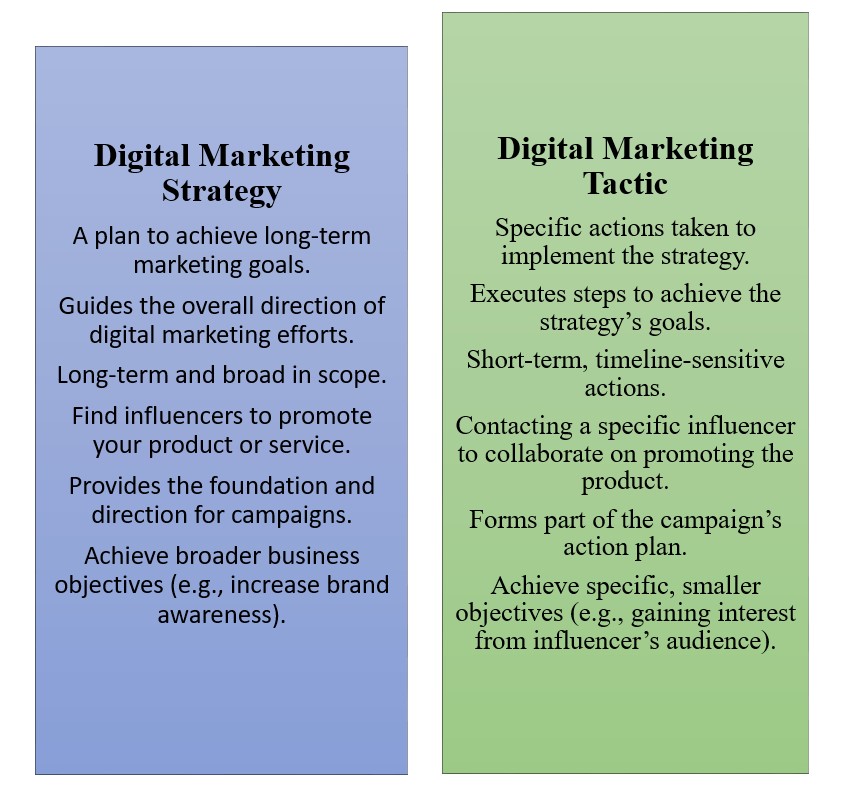Most of us rely on our smartphones, tablets, and computers. We consume a significant amount of information through these devices, which is why having a strong digital marketing strategy is crucial for any business owner.
However, to reach potential customers effectively, your marketing efforts need to be present where people are active—on search engines and social media.
By optimizing your presence on these platforms, you can boost your conversion rates, ultimately leading to increased sales and revenue.
Digital marketing is important because it is measurable and flexible. You own the ability to connect with a worldwide audience and customize your tactics to focus on particular groups.
Moreover, there’s always something new to learn in the digital field, regardless of experience level in marketing. The secret is to remain flexible, to be open to trying new things, and to keep improving your tactics.
What is Digital Marketing
A digital marketing strategy is a comprehensive plan designed to position a product or brand in front of potential customers.
The aim can range from increasing brand awareness to achieving specific revenue goals.
This strategy operates uniquely through digital channels like search engines, websites, and social media.
Moreover, it involves using targeted tactics to reach your audience effectively. For example, one tactic could be running social media ads tailored to the demographic most likely to be interested in your product or service.
Why Every Business Needs a Solid Digital Marketing Strategy
Understanding the importance of a digital marketing strategy can make a huge difference in how you manage your business’s growth.
Here’s why putting effort into crafting a solid digital marketing plan is crucial:
Understanding Market Share
A well-defined strategy gives you a clearer picture of your market share. Without it, you might misjudge the demand for your products or services. A good strategy helps you understand the market better, considering customer behaviors, needs, competitors, and customer profiles.
Stay Ahead of Competitors
Your competitors are likely using digital marketing to capture market share while you stick with traditional methods.
Investing in digital marketing ensures that you stay visible to your target audience and remain part of their purchasing decisions. Without it, you risk losing out as competitors attract potential customers who should be yours.
Create a Strong Online Value Proposition
A digital marketing strategy helps you craft an online value proposition that enhances the buying experience.
This means your brand becomes more appealing to various customer types because it’s well-priced and easy to purchase.
The aim is to build a loyal customer base that loves your products and shares their positive experiences.
Understand Your Customers Better
Utilizing digital tools for user feedback allows you to grasp customer sentiment about your products or services. Conducting online surveys, gathering reviews, and analyzing feedback helps you tailor your marketing tactics to what works best for your audience.
It also lets you adjust your offerings to better meet your target market’s needs.
Stay Flexible in a Competitive Market
Leading brands frequently adapt their strategies and user experiences to stay ahead. Your business should also be dynamic and adaptable, ready to adjust based on consumer preferences and market trends.
This flexibility helps you remain competitive and relevant in a constantly evolving marketplace.
Difference Between Digital Marketing Strategy and Tactic

How to Develop an Effective Digital Marketing Strategy?
Developing a strong digital marketing strategy is essential for achieving your business goals. Here’s a concise guide to creating an effective strategy:
Customer Persona: Identify your ideal customer based on behaviors, preferences, and pain points to better target your audience.
Set Clear Goals: Establish measurable goals like brand awareness or conversion rates, using tools like Google Analytics to track progress.
Content Creation: Create a consistent content calendar with blogs, ads, or social posts to keep your brand top of mind.
Evaluate Current Channels: Review your current marketing efforts and reallocate resources to the most effective ones.
Automation: Implement automation tools to streamline tasks such as content posting or lead management.
Mobile Optimization: Ensure your site and campaigns are mobile-friendly for a seamless user experience and improved SEO.
Engagement: Be responsive to customer inquiries on social media and ads to foster trust and improve conversions.
Use the Right Technology: Leverage CRM systems, automation software, and AI to reduce workload and focus on key tasks.
Highlight Your USP: Make sure your unique selling proposition (USP) is clear in all marketing efforts.
Track Progress: Regularly monitor campaigns, adjust where necessary, and focus resources on successful tactics.
This approach ensures your marketing strategy is comprehensive, targeted, and adaptable for long-term success.
Top 10 Digital Marketing Strategies to Boost Your Business Growth
The digital marketing strategies that once worked might need a fresh approach to align with the latest trends and technologies.
Here are the top 10 digital marketing strategies to boost your brand in 2024.
Influencer Marketing
Influencer marketing continues to be a powerful strategy in digital strategies.
However, partnering with influencers helps build credibility for your business while providing direct access to a target audience. Research shows that a significant portion of marketing budgets—about 25%—is now allocated to influencer campaigns, highlighting their importance.
Tip: Focus on micro-influencers. While their follower count may be smaller, they have a highly engaged audience interested in niche offerings, which can lead to better business outcomes for your brand.
Social Media Marketing(SMM)
With over 5 billion active social media users worldwide, platforms like Instagram, Facebook, and LinkedIn play a dynamic role in shaping corporate image.
Social media marketing also fosters a sense of community and facilitates direct communication with consumers.
So, diversify your content to keep your audience engaged. Use a mix of stories, live videos, and customer-generated content to boost interaction and strengthen brand loyalty.
Content Marketing
Today’s customers aren’t just looking for products or services; they want solutions to their problems. Content marketing allows your business to become a trusted resource by providing valuable, relevant information.
Whether it’s through blog posts, infographics, or videos, the goal is to educate your audience, address their concerns, and align your brand as the solution.
Tip: Ensure your content is SEO-friendly for every topic. Meeting customer expectations with relevant content will capture their attention and increase the chances of conversions.
Paid Advertising(PPC)
However, getting your website to rank organically is ideal, but sometimes paid advertising is necessary to boost visibility. Platforms like Google Ads, Facebook, and Instagram offer pay-per-click (PPC) options, allowing you to target specific audiences and generate traffic quickly.
So, if your budget is limited, start small and experiment with different ad formats and messaging. Once you identify what works for your industry and resonates with your target audience, increase your efforts to achieve a strong return on investment (ROI).
Voice Search Optimization
Voice search optimization is essential for 2024, as devices like Alexa, Google Assistant, and Siri are increasingly used. By modifying your content for voice search, you can tap into new audiences who rely on voice commands to find information.
However, to improve your chances of ranking in voice search results, make sure your content is conversational and user-friendly.
Focus on incorporating long-tail keywords, especially if you’re aiming for Google’s featured snippet, to increase visibility.
Search Engine Optimization(SEO)
SEO continues to be an initial digital marketing strategy. Appearing on the first page of search engine results is crucial, as 60% of all online purchases start with a search engine.
Keeping up with SEO algorithm changes is dynamic, as they can significantly impact your site’s ranking, either boosting visibility or leaving it buried in search results.
So, conduct an SEO audit regularly. Ensure your website is optimized with the right keywords, addresses technical SEO factors, and has the necessary backlinks to stay competitive in search rankings.
Video Marketing
The rapid growth of platforms like YouTube, TikTok, and Instagram Reels has made video content one of the most powerful ways to engage with customers.
In fact, 92% of marketers now use video due to its significant role in delivering a positive ROI.
Tip: Vary your video formats—create product demos, behind-the-scenes clips, and customer testimonials. Test different types to see which resonates most with your audience.
Don’t forget to include eye-catching visuals to make your content even more engaging and impactful.
E-Mail Marketing
Email marketing remains one of the most cost-effective advertising methods available.
Recent surveys show that nearly 60% of buyers say emails influence their purchasing decisions, making it a valuable tool for nurturing leads, introducing new products, and building customer loyalty.
For better results, personalize your emails to specific audience segments. Tailoring messages to align with customer interests and behaviors can boost engagement and increase conversions.
Affiliate Marketing
Affiliate marketing is a highly effective promotional strategy due to its low-risk, high-reward nature.
With this approach, you only pay for performance—typically when a sale is completed or a lead is generated.
It’s an excellent way to reach new audiences and collaborate with individuals who align with your brand.
Moreover, establish clear guidelines and commission structures for your affiliate partners to ensure mutual benefit. Provide them with quality marketing materials and support to help them effectively promote your offerings.
Local Search Marketing
Local search marketing is essential for businesses with physical locations, as it leverages your business’s geographic area.
By optimizing your website and business listings with local SEO techniques, you can improve your visibility in searches from nearby customers. Tools like Google My Business allow you to manage the information displayed about your business, ensuring potential customers get accurate details.
However, regularly update your Google My Business listing, including business hours, physical address, and service reviews, to keep information current and reliable.
Key Digital Marketing Mistakes to Avoid and How to Fix Them
Neglecting Mobile Users
Failing to optimize for mobile can alienate a large segment of your audience. Ensure your website is responsive and content is accessible on all devices.
Overlooking Analytics
Not leveraging analytics is a common mistake. Use data to guide your decisions and assess campaign performance for continuous improvement.
Ignoring Customer Feedback
Ignoring customer feedback can stunt your growth. Pay attention to what your customers are saying, respond to their concerns, and adjust your strategies to enhance their experience.
How to Measure Your Digital Marketing Success?
Measure the following factors and modify strategies to improve your marketing success.
Analyze Traffic and Engagement
Review metrics like page views, time on site, and bounce rate to gauge how well your digital marketing is performing and understand user behavior.
Track Conversion Rates
Measure how effectively your campaigns turn visitors into leads or customers. Tracking conversion rates helps identify which strategies yield the best results.
Evaluate ROI
Assess the return on investment (ROI) by comparing the revenue from your campaigns to their costs. This helps determine profitability and guide budget decisions.
Wrap Up
Developing a successful digital marketing plan requires time and effort.
You may use a variety of strategies and campaigns to achieve your ultimate objectives of sales and brand awareness.
So, be patient with your approach and track your progress so that you can make necessary tactical adjustments.



